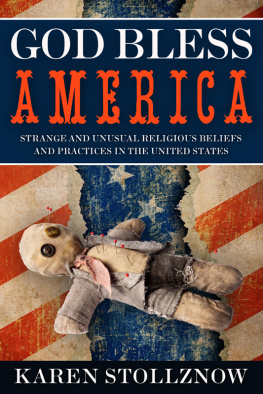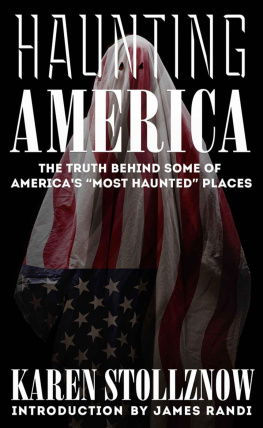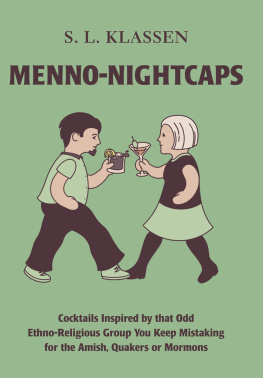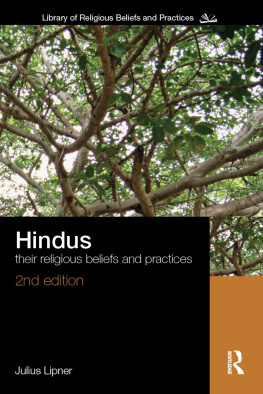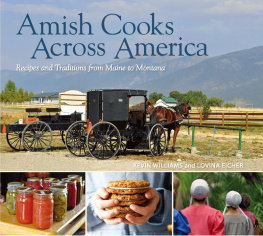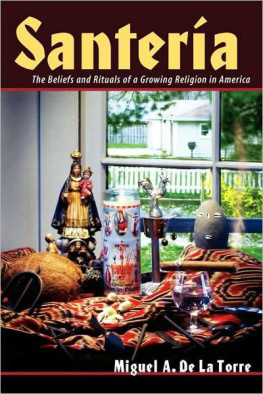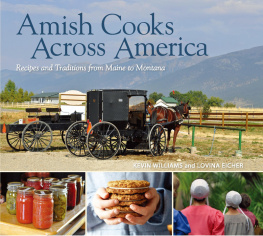
Pitchstone Publishing
Durham, NC 27705
www.pitchstonepublishing.com
Copyright 2013 by Karen Stollznow, PhD
All rights reserved.
To contact the publisher, please e-mail
Printed in the United States of America
19 18 17 16 15 14 13 1 2 3 4 5
Library of Congress Cataloging-in-Publication Data
Stollznow, Karen.
God bless America : strange and unusual religious beliefs and practices in the United States / Karen Stollznow, PhD.
pages cm
Includes bibliographical references and index.
ISBN 978-1-939578-00-6 (pbk. : alk. paper)
1. ChristianityUnited States. 2. United StatesReligious life and customs. 3. United StatesReligion. I. Title.
BR515.S753 2013
277.3dc23
2013012481
ISBN: 9781939578082
Contents

Acknowledgments

Im deeply grateful to Matthew Baxter, Bryan Bonner, Rick Duffy, and Nikolas Kovacevic for their unwavering support, advice, and research assistance throughout the writing of this book. My sincere thanks also go to the following friends, family, and informants for their feedback and insight: Michelle Adcock, Banachek, Jere Baxter, Mick Baxter, Mark Bunker, Kernan Coleman, Jamie DeWolf, Tim Farley, Brent Jeffs, Kathy Josey, Reed Esau, Todd Everingham, Stu Hayes, Leon Hostetler, Matthew Kennedy, Rich Orman, Tana Owens, Kelly Nelson, Gaye Stolsnow, John Stolsnow, Paul Turner, and Robert Walker. Finally, Id like to express gratitude (of the nonNew Age kind) to Kurt Volkan of Pitchstone Publishing and to Suzy Lewis of the Richard Dawkins Foundation for Reason and Science for having faith (of the nonreligious kind) in this project. God Bless America was made possible because of all of you, and this book is for all of you.
Introduction

Do Satanists really sacrifice babies? Can a Voodoo priest turn a person into a zombie? What happens during an exorcism? Are the Amish allowed to drive cars and use computers? God Bless America finds the answers to these questions and many more.
This book explores a range of unique religious beliefs and practices in the United States, including those of the Amish and Mennonites, the Fundamentalist Mormons, and the Quakers, and those found within Charismatic Christianity and Pentecostalism, Voodoo and Santeria, Satanism, Scientology, and New Age Spirituality. These religions encompass beliefs in a God or gods, Satan, Spirit, ghosts, aliens, and UFOs, and draw their theology from doctrines as diverse as the Book of Acts, science fiction, and the Law of Attraction. We look at a wide range of customs and ceremonies, including snake handing, Satanic rituals, Hoodoo spells, shunning technology, polygamy, and healing by gaze.
Few of these religions are all American, as many have origins elsewhere and arrived in the United States only after their followers fled their home countries escaping persecution for their religious beliefs. The United States has traditionally been a haven for people seeking sanctuary and religious freedom. In waves of immigration, Jewish people from across Europe found refuge in America from anti-Semitism, repeated pogroms, and the Holocaust. During the seventeenth century, the Puritans and the Quakers settled in North America to escape persecution in England, whereupon the Puritans began persecuting the Quakers.
Inscribed on a plaque at the base of the Statue of Liberty is The New Colossus, the famous poem by Emma Lazarus. The sculpture is a symbol of freedom, and the sonnet a greeting to immigrants. Its final lines are a testimony to acceptance and inclusion. Give me your tired, your poor, your huddled masses yearning to breathe free. The wretched refuse of your teeming shore. Send these, the homeless, tempest-tost to me, I lift my lamp beside the golden door! In this welcoming spirit, the United States has cultivated an environment of religious tolerance, while freedom of religion is protected in the First Amendment of the Constitution.
Many Americans defend the right to religious freedom, regardless of whether they agree with the beliefs or not. Part of the American ethos is that its okay to do whatever you want to do, just as long as you dont hurt other people. Unfortunately, some of these religious practices do hurt other people. Several of these religious groups are closed societies, allowing corruption to flourish. Religious freedom becomes an excuse to commit crimes under guise of God. This freedom has become oppression for some people, and many religious beliefs and practices endanger the physical and psychological health of their followers.
For many people, religious beliefs, and by extension religious practices, are viewed as untouchable, sacred, and inviolable. It has become a taboo to question personal beliefs. Religion is indulged with unquestioning respect, and people shy away from scrutinizing religious practices in fear of being seen as discriminatory or offensive. When abuses occur in these communities, some people simply look the other way, including the authorities. Others argue, whats the harm? This book uncovers the considerable harm enacted in the name of religion, including underage marriage, rape, human trafficking, inbreeding, incest, violent exorcisms, risky rituals, social shunning, animal sacrifice, financial scams, faith healing, and dangerous diets. Fortunately, while the First Amendment protects beliefs, the free exercise of practices is not absolute.
However, there is a paradox. Despite these ideals of tolerance and religious freedom, some religious groups are stigmatized, misunderstood, and mocked for being different. Fair or unfair, right or wrong, they have developed negative reputations. Fundamentalist Mormon groups are denigrated as cults. Satanists continue to be accused of committing Satanic ritual abuse, decades after such charges have been disproven. In a hate crime known as claping, Amish people are harassed, their buggies are driven off the road, and their horses attacked with firecrackers or water bombs. Practitioners of Hoodoo and Voodoo are either feared as evil and bloodthirsty, or ridiculed as primitive and superstitious. Scientologists and New Agers are often the butt of jokes, while snake handlers and televangelists are lampooned mercilessly.
God Bless America attempts a sensitive but factual portrayal of these people who believe they have found the truth. They clearly havent discovered the meaning of life, but all of these belief systems offer profound insights into the human condition, and we can occasionally see ourselves in them. As different as they appear at first, some aspects of these religions may resonate with you. Like medical students who become convinced that theyre afflicted with all of the diseases they study, when I researched the Quaker testimonies, I thought, at times, I think Im a Quaker!that is, until I found out about the silent worship. In reading The Satanic Rituals, I identified with the humor and humanism of Satanism and concluded, I think Im a Satanist!that is, until I got to the part about the barnyard costumes and the magic spells. The discussion is also critical of religion when it needs to be. Many of these beliefs and practices will seem shocking and dangerous at worst, or absurd and archaic at the very least.
Next page
